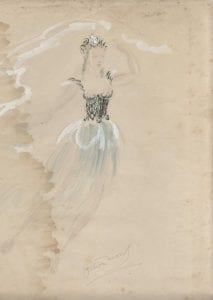This month’s object of the month is a costume sketch by Oliver Messel for the 1940 Sadlers’ Wells ballet The Mask of Comus.
This is a drawing for the costume of the water sprite Sabrina from the 1942 production of The Mask of Comus by the Sadlers’ Wells ballet. Based on a masque written by John Milton for John Egerton, first Earl of Bridgewater and first performed in 1634, Comus was reworked as a ballet by Robert Helpmann for the Sadler’s Wells Ballet in 1942. It starred Helpmann as the eponymous Comus and Margot Fonteyn as The Lady. Oliver Messel took time from his war-time duties to design the sets and costumes.
The plot concerns a virtuous lady who, becoming lost in the woods, meets Comus, the son of Bacchus who leads her to his castle where she is imprisoned by his enchantments and tempted into intemperance, sensuality and vice. The lady’s brothers, on trying to rescue her, are helped by a magical attendant who conjures the water nymph Sabrina who finally frees the Lady. For the costume of Sabrina, Messel uses his quintessential skirt of layers of painted gauze fabric to form a light floating, nymph-like costume rather than the more familiar stiffened tutu. He also designs a head-dress to resemble the “twisted braids of lilies knitting The loose train of thy amber-dropping hair” that Milton describes in the poem. The character of Sabrina also provided the inspiration for the title character of the 1954 Billy Wilder comedy Sabrina Fair, starring Audrey Hepburn, Humphrey Bogart and William Holden.
The drawing comes from the personal archive of theatre designer Oliver Messel. Oliver Messel began his theatrical career in the 1920s by designing masks for Serge Diaghilev’s Ballets Russes and for the annual theatrical revues of C.B Cochran. He moved on through the 1930s to designing stage productions, working with theatrical greats including Vivien Leigh, John Gielgud and Michael Redgrave. As well as designing for theatre and dance productions, Messel also designed nine films, the first being The Private Life of Don Juan with Merle Oberon and the last being Suddenly Last Summer with Katherine Hepburn, Montgomery Clift and Elizabeth Taylor. During the Second World War, he worked as a camouflage officer, using his famed ability as a theatrical designer to disguise pillboxes as barns and haystacks as well as using painted canvas to create fields of fake lorries. Following the war, Messel returned to stage design with the Royal Ballet’s famed production of Sleeping Beauty. Throughout the 1950s Messel continued to design for theatre and opera before moving to Barbados in 1966 where he embarked on an additional career as a designer of houses and villas in Barbados and nearby Mustique.
The cataloguing and conservation of the Personal Archive of Oliver Messel has been generously funded by grants from the Heritage Lottery Fund, the Linbury Trust, the Friends of the Theatre Collection and others.

